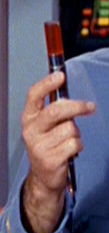Archer4real (talk | contribs) No edit summary |
|||
| Line 21: | Line 21: | ||
The Doctor used fifty [[milligram]]s of cordrazine to stabilize [[Tuvok]] in [[2373]] when a [[gaseous anomaly]] unearthed repressed memories in Tuvok. ({{VOY|Flashback}}) |
The Doctor used fifty [[milligram]]s of cordrazine to stabilize [[Tuvok]] in [[2373]] when a [[gaseous anomaly]] unearthed repressed memories in Tuvok. ({{VOY|Flashback}}) |
||
| + | |||
| + | Later that year, The Doctor used ten milligrams of cordrazine in conjunction with a [[cortical stimulator]] to revive [[Kathryn Janeway]] after an alien had invaded her [[cerebral cortex]]. ({{VOY|Coda}}) |
||
{{bginfo|Since cordrazine was usually measured in ccs (equivalent to [[milliliter]]s), it is hard to make a relative comparison of the amount administered to Tuvok. However, it is five times what Bashir used on [[Luther Sloan]], a [[Human]]. This suggests that [[Vulcan]]s may require higher doses of this medicine than Humans.}} |
{{bginfo|Since cordrazine was usually measured in ccs (equivalent to [[milliliter]]s), it is hard to make a relative comparison of the amount administered to Tuvok. However, it is five times what Bashir used on [[Luther Sloan]], a [[Human]]. This suggests that [[Vulcan]]s may require higher doses of this medicine than Humans.}} |
||
Revision as of 19:39, 31 October 2012

Cordrazine
Cordrazine was a strong chemical stimulant useful for emergency medical treatment. It was primarily used to stimulate the heart during cardiac arrest. The drug was a red liquid and was injected with a hypospray. In 2267, Captain Kirk noted that cordrazine was "tricky stuff," (TOS: "The City on the Edge of Forever") but by the 24th century, it had become ubiquitous and was being used by physicians in much higher doses than in Kirk's day. (TNG; DS9; VOY)
History

Hikaru Sulu upon treatment with cordrazine
Hikaru Sulu, suffering from heart flutter after being shocked by the bridge console while passing through a time displacement, was revived by a few drops of cordrazine. Dr. Leonard McCoy then suffered an extreme overdose when he accidentally injected an excessive amount of the chemical into his body. (TOS: "The City on the Edge of Forever")
Dr. McCoy also used one cc of cordrazine to revive Rizzo to consciousness. (TOS: "Obsession")
A more potent form of cordrazine, called tricordrazine, is commonly used in resuscitation in the 24th century. Dr. Beverly Crusher attempted to use tricordrazine to revive Worf after he went into heart failure, following a risky surgery using the genitronic replicator to repair his damaged spinal column. (TNG: "Ethics")
In 2369, Dr. Crusher told her staff to prepare a cordrazine series for Jean-Luc Picard after his artificial heart was damaged and the captain was failing fast. (TNG: "Tapestry")
In 2371, Bareil Antos was given two ccs of cordrazine by Julian Bashir and Jabara. Bashir himself was given four ccs of cordrazine several weeks later, after being placed in a coma following Altovar's attack. (DS9: "Life Support", "Distant Voices")
The Doctor used two ccs of cordrazine to revive Harry Kim after he was killed by a Vhnori cenotaph. (VOY: "Emanations")
On "Planet Hell" in 2372, Neelix suggested that Tom Paris administer cordrazine to an ailing repto-humanoid infant. (VOY: "Parturition")
Bashir gave cordrazine to several Teplans in 2372, hoping to alleviate the pain caused by the Dominion's Teplan blight. Epran and Ekoria were among those given the drug, although the former had stopped responding to it before he died. Bashir was concerned that the high level of the drug he'd administered to Ekoria might be hard on her baby's metabolism. (DS9: "The Quickening")
The Doctor used fifty milligrams of cordrazine to stabilize Tuvok in 2373 when a gaseous anomaly unearthed repressed memories in Tuvok. (VOY: "Flashback")
Later that year, The Doctor used ten milligrams of cordrazine in conjunction with a cortical stimulator to revive Kathryn Janeway after an alien had invaded her cerebral cortex. (VOY: "Coda")
In late 2375, Bashir gave ten milligrams of cordrazine to Section 31's Luther Sloan who had attempted suicide, although only as part of a mental simulation created by the multitronic engrammatic interpreter. (DS9: "Extreme Measures")
In 2376, The Doctor used twenty milligrams of cordrazine during an emergency resuscitation to revive B'Elanna Torres from an induced catatonic state, to which she did not respond. (VOY: "Barge of the Dead")
Overdose

McCoy in a cordrazine frenzy caused by an overdose in 2267
Excessive amounts of this drug produce temporary delirium with violent behavior, as the recipient enters into frenzies of extreme paranoia. This includes inability to recognize acquaintances and the fear of mortal danger. Those suffering from an overdose may experience occasional loss of consciousness and exhibit confusion, weakness, and high fever, pale green and red mottled skin. (TOS: "The City on the Edge of Forever") Twenty-five ccs of tricordrazine was enough to kill a Klingon. (TNG: "Ethics")
Background
Cordrazine was mentioned as a (possibly fictional) drug in the 1968 Mission: Impossible episode "The Freeze". While trying to convince a bank robber that he has been cryogenically frozen and revived eleven years later, IMF agent Rollin Hand poses as a doctor and asks the nurse to give the patient "five ccs of cordrazine". Mission: Impossible was filmed on the same lot as Star Trek. Alexander Singer, who directed "The Freeze", went on in later years to also direct many episodes of The Next Generation, Deep Space Nine, and Voyager.
